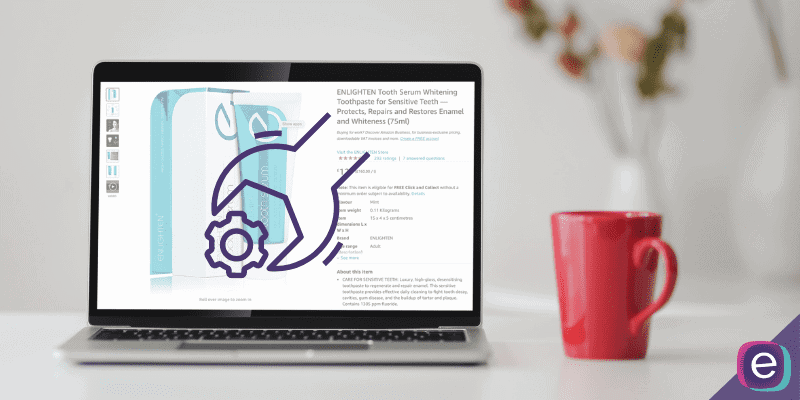When it comes to Amazon listing optimisation, a lot of brands wonder about making updates to content in Seller Central or Vendor Central. While it’s important to keep your SEO fresh, relevant, and on target, you also need to allow time for your content to perform in the Amazon algorithm. This blog will detail some important points to consider when it comes to updating your Amazon listings.
What does listing optimisation mean?
Listing optimisation means writing or editing your content (titles, bullets, product descriptions, and backend search terms) to be better and more efficient. Optimised Amazon listings will surface more frequently in Amazon’s search results. They will also convert better once a customer lands on the item’s detail page. This is because they’ll provide customers with the information they need to decide on their purchase after they arrive on the page. The best way to optimise your Amazon detail pages is a good balance of SEO-rich keywords and readable, useful information.
How to update Amazon listings
To update your Amazon content, you’ll need to go into Seller Central or Vendor Central and edit the listing information. If you already have Amazon content, you’ll want to update it periodically. This might mean just slightly tweaking search terms on the backend or your existing catalogue, or it might mean an entire refresh with new product bullets and product descriptions.
Why should I update and refresh my Amazon content?
We’ve talked before about avoiding common listing optimisation errors. Brands may need to update listings to remedy a problem (such as not forgetting to input backend search terms, or not following Amazon guidelines). Even if you believe your listings are solid, with all pieces accounted for, it’s important to occasionally update your content to ensure it still performs for your business.
Well-done updates and listing optimisation can majorly pay off in search results on Amazon, so you’ll want to pay attention to any gaps or opportunities. For example, if a business is looking to lower ACOS for Amazon Ads, they can update their listings to include top-performing keywords from ads to make their listings perform better in organic search, versus paid search.

A screenshot of optimised bullets on Amazon.com
Six tips to update your Amazon listings
1. Know your category
Be sure to list your items correctly in the appropriate categories. You’ll also want to pay attention to competitors. What keywords are they using? What are the bestsellers in the category? Do your research to ensure you can beat the competition.
2. Know your product
You don’t want updates to cause problems for your listings. If you are updating your product information and optimising listings, ensure the changes have time to work into the algorithm before your peak season. For example, if you are selling workout shirts and your peak sales usually occur in January, make sure your changes are submitted and live onsite before December. This gives the search terms you added and the work you did time to build history before your peak season.
If your product listings have been live for a while, pay attention to the particularities of your items. Are customers asking about a certain feature? Are they confused about how to assemble the product? Looking at the customer questions or negative reviews can give you clues to any quality issues or gaps in knowledge. If you don’t provide customers with information to make an educated decision on their purchase, or if their purchase isn’t aligning with expectations, you should definitely update your listings to provide more details. At eCommerce Nurse, we frequently advise clients to let us add this type of information. Such as, how to assemble a product, the amount of time a bottle of product lasts, details about the scent or flavour, etc.
3. Ensure your brand adds variations correctly
When a brand has a successful product, they’re likely to want to add more variations to it at some point. Perhaps they start making three-packs of a popular candle or other colourways of a bestselling photo frame. On Amazon, variations are a great way to cross-sell items and allow customers to easily shop your products. Our agency sees a lot of brands (even huge, global brands) adding products incorrectly. This destroys the customer experience and also makes it harder for a new product to succeed on Amazon. New variants should be set up as twister variations on Amazon, which means they will be on the same product detail page.
When optimising your listings, first ensure the variations are set up correctly. Then, ensure the product pages are optimised to account for all variations. For example, product bullets should not refer to “orange scent” if other variations on the same page come in lavender, lemon, and sage.
4. Leave your pages alone during Q4
During Q4, there is a lot of traffic on Amazon and you want your product listings in tip-top shape. But October to December is not a good time to make changes to your pages. One reason is that the changes will not have time to perform well. Another reason is that if something does go wrong, you risk taking a sales hit. If Amazon suspends your product, for example, because you added the word “non-toxic” to the description, you may have trouble getting it reinstated or resolved quickly.
Make all your pages peak-season ready in September. If something does go wrong, you will likely be able to fix it in time for Black Friday and beyond. Plus, if you need help, Amazon support is likely to be less busy and easier to work with.
5. Check for keyword trends quarterly
Even if your pages are performing well and you’re not experiencing customer questions or issues, you’ll want to revisit the hidden keywords quarterly. This helps you account for any new trends or SEO changes to the category. For example, perhaps you have a new competitor, or perhaps you want to add top-performing keywords from your Sponsored Products campaigns. Checking and revising hidden keywords and titles quarterly can keep you on track for success, even if you rarely touch other pieces of your product page.
6. Don’t forget about A+ Content
While the listing optimisation we’ve discussed in this blog pertains to titles, bullets, product descriptions, and hidden keywords. But it’s important for Brand Registry sellers and vendors to take full advantage of their product page and utilise A+ Content. This provides even more space to answer customer questions, provide details about the item and unique selling points, use charts to cross-sell the brand’s range, show the product in use, and tell about the brand. This content is the icing on the cake, once you’ve got the basic listing optimisations in place for your top-selling products.
Tips for Amazon vendors (and sellers!) on Amazon listings
For some quick help on listing optimisation, watch our Vendor Society Interview series on this topic on our YouTube Channel.
More help with Amazon listing optimisation
If all of this sounds overwhelming, you’re not alone. The process of listing optimisation, upload, product refreshes, ongoing keyword research and implementation of a marketing strategy can be a lot for many businesses to manage. Don’t go it alone. eCommerce Nurse offers a range of services to help businesses of all sizes. If you need more help, take a look at our listings optimisation and product acceleration packages, and be sure to contact us!




